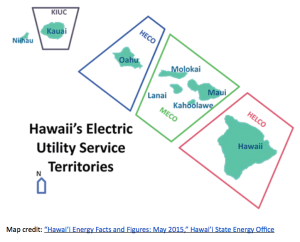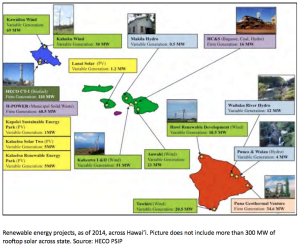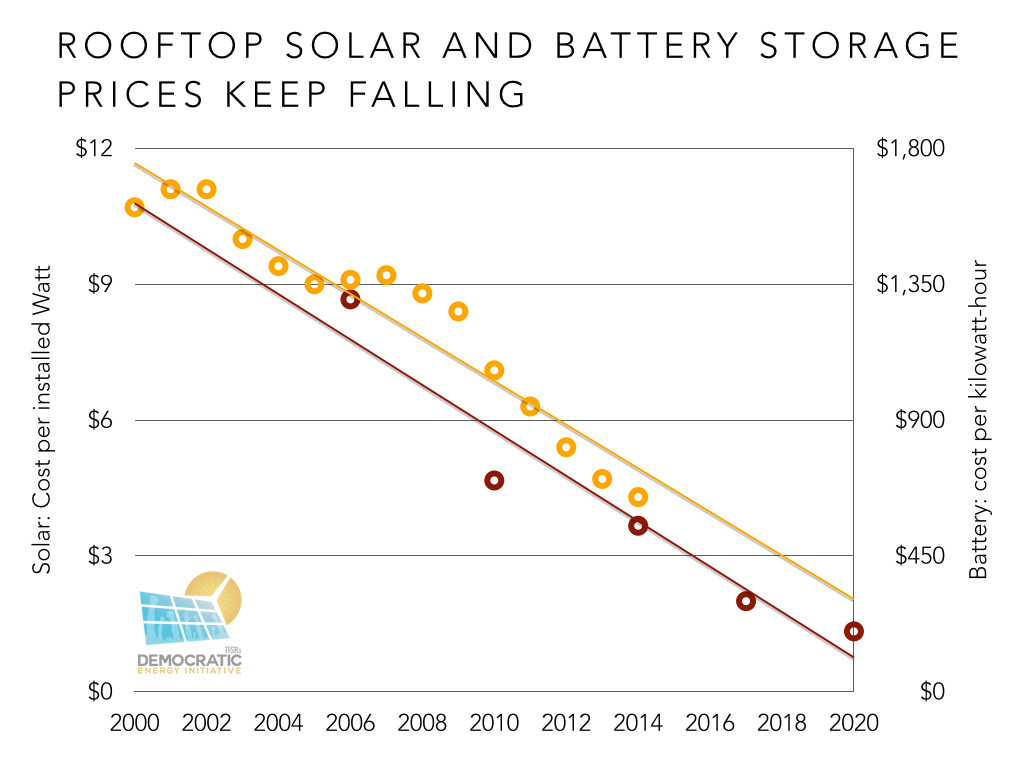Hawai’i At The Energy Crossroads — Part 1: How We Got To Now
Originally published on ilsr.org.
On the one hand: Sky-high electricity prices. A 20th century electricity system burning fuel oil and controlled by large monopoly electric utilities. A proposed utility takeover.
On the other hand: A new 100% renewable energy standard. Rooftop solar on one of ten homes, saving each customer hundreds of dollars per year. Cost-effective energy storage. A rising interest in locally controlled utilities.
Welcome to Hawai’i at the Energy Crossroads.
Below is part one of Hawai’i at the Energy Crossroads, a report released in October 2015 about the tough choices facing the islanders as they stand on the cusp of an electric grid transformation. Be sure to come back and read parts 2 and 3, published in the next couple of weeks.
In the next year, Hawai’i faces decisions that will determine how and if it can meet its 100% goal. Immediately, it includes how to value rooftop solar production and whether to approve a takeover of the Hawaiian Electric (HECO) companies by NextEra Energy, a multi-billion-dollar, Florida-based energy company. But beneath the surface, there is a fundamental question of whether power should be generated from the top down or the bottom up.
Hawai’i can achieve 100% renewable energy by focusing on decentralized renewable power. And it can do it for cheaper, with more broadly distributed economic benefits, than its electric utilities are proposing. The following chart illustrates the opportunity for cost-effective distributed electricity.
In contrast, the HECO companies and NextEra are planning a costly, large-scale approach. They want to import liquefied natural gas to supplant fuel oil, slowing the transition to renewable energy and likely costing customers more. They have plans for an inter-island transmission cable to support large-scale renewable energy projects that have, historically, failed to prove cost effective, and that aren’t likely to be economically or environmentally attractive to their customers.
This crossroads is unique to Hawaii in 2015, but the questions it poses are a “postcard from the future” that will confront all electric utilities and their customers across the United States in the next decade. Will electric customers be able to seize the opportunity of distributed power generation? Or will utility companies maintain their monopoly over the power and economic rewards of the electricity system?
 Chip in a few dollars a month to help support independent cleantech coverage that helps to accelerate the cleantech revolution!
Chip in a few dollars a month to help support independent cleantech coverage that helps to accelerate the cleantech revolution!
Decision Point
In Hawai`i, as in the rest of the United States, the electricity system has largely remained in the hands of regulated monopoly utility companies – in this case, the Hawaiian Electric (HECO) companies, which include the Maui Electric Company (MECO) and the Hawaiian Electric Light Company (HELCO). One island, Kauai, is served by an electric cooperative, the Kauai Island Utility Cooperative (KIUC), where customers also own their electric utility. These Hawaiian utilities are wholly responsible for everything from the large, centralized power plants to the transmission and distribution power lines to the meters on homes and businesses. For years, that system made sense, when the only economical way to generate electricity or manage the electric grid was through large-scale fossil-fueled power plants.


Renewable energy projects, as of 2014, across Hawai’i. Picture does not include more than 300 MW of rooftop solar across state. Source: HECO PSIP
But the rise of rooftop solar, batteries, and distributed computing like smartphones has fundamentally changed the technological and economic paradigm. Many state regulators, from Maine and Minnesota to New York and California, are already exploring how the decentralizing energy technology of the 21st century suggests decentralizing control of the electricity system.
For Hawaiians, there is an added twist.
Unlike almost anywhere else in the country, the state depends entirely on imported fuel oil for its electricity. As recently as 2003, more than 90% of the islands’ electricity came from fuel oil. When crude oil prices rise, electricity rates follow. Until the past few months, electricity on the islands cost more than 30 cents per kilowatt-hour, double or more than mainland prices, mirroring the per-barrel prices of crude oil.
Meanwhile, electricity sales have been flat since 1997 even while Hawai’i’s gross domestic product doubled.
To combat high and volatile electricity rates, Hawaiians installed rooftop solar on their homes. Already, one out of every three single-family homes have rooftop solar, contributing to more than 70,000 systems around the state, one of the highest penetrations of rooftop solar in the world. Costs for rooftop solar continue to decline more than 10% per year. Costs for energy storage that can hold and shift excess solar energy production are declining just as fast.
Amid the surge in rooftop solar, Hawaiian electric utilities have built more renewable power plants to meet state mandates, including wind power and geothermal. Today, more than 20% of the electricity sold on the islands is from renewable resources, including more than half the energy on Hawai’i Island and more than one-third on Kauai.
It’s only the start. A new state law compels electric utilities to power 100% of their net electricity sales with renewable energy by 2045, up from 40% by 2030.
Thus far, utilities and their customers have been able to advance renewable energy along the two parallel paths of centralized and decentralized power. But to reach 100% renewable energy, it may be too costly to support both a 20th century centralized and 21st century decentralized strategy. A power plant or power line built today will still be operating in 2045, creating what is known as “path dependency,” making it harder to invest in decentralized alternatives in the future. The competition between these visions will reverberate, materially and socioeconomically, for years.
Hawai’i’s power is shifting, literally, from the utilities to their customers. Yet the 20th century vision for Hawai’i – as advanced by the utilities – includes arbitrary limits on distributed generation such as rooftop solar. It includes importing liquefied natural gas (LNG), and making massive investments for relatively small savings when equally large investments are needed in renewable energy, storage, and a redesigned grid.
Last century’s vision includes an additional factor: a takeover of the HECO companies by NextEra Energy, a $17-billion company from the mainland that employs nearly 14,000 people in 27 states. Last year, NextEra offered $4.3 billion to take over the HECO companies, which serve 95% of Hawai`i’s population. Only the Kauai Island Utility Cooperative is not included in the NextEra deal.
NextEra is comprised of more than 900 subsidiaries, and is best known for NextEra Energy Resources and Florida Power & Light. The former is the largest unregulated generator of wind and solar power in the nation; the latter is one of the largest regulated monopoly utilities in the US.
 The merger is controversial, not just for the change in ownership and control of the island state’s largest utility, but because it also reinforces the centralized approach to clean energy. NextEra’s unregulated subsidiaries build utility-scale renewable projects, but have no experience in managing rooftop solar or soliciting bids from third-party developers. Likewise, subsidiary Florida Power & Light (FPL) has a history of actively opposing renewable energy, especially rooftop solar, and is highly reliant on centralized power generation from nuclear fuel and natural gas. Several signs point to the new merged entity becoming another Florida Power & Light: NextEra has expressed interest in replacing imported oil with imported liquefied natural gas to fuel Hawai`i’s power plants, along with constructing an inter-island undersea transmission line to serve O’ahu’s energy needs from large renewable energy projects sited on less populated islands.
The merger is controversial, not just for the change in ownership and control of the island state’s largest utility, but because it also reinforces the centralized approach to clean energy. NextEra’s unregulated subsidiaries build utility-scale renewable projects, but have no experience in managing rooftop solar or soliciting bids from third-party developers. Likewise, subsidiary Florida Power & Light (FPL) has a history of actively opposing renewable energy, especially rooftop solar, and is highly reliant on centralized power generation from nuclear fuel and natural gas. Several signs point to the new merged entity becoming another Florida Power & Light: NextEra has expressed interest in replacing imported oil with imported liquefied natural gas to fuel Hawai`i’s power plants, along with constructing an inter-island undersea transmission line to serve O’ahu’s energy needs from large renewable energy projects sited on less populated islands.
In contrast, at least one study suggests that each island is capable of meeting its own electric needs with on-island renewable resources.
Most public officials in Hawai’i strongly support locally generated renewable energy. Hawai`i’s Governor David Ige has said he opposes both the NextEra takeover and plans to import natural gas. Maui County Mayor Alan Arakawa has publicly stated a need for the county to achieve 100% renewable energy, even ordering his staff to study whether a municipal or cooperative utility can help the county achieve this goal more quickly than the incumbent MECO:
“…we could produce 100 percent of all of the energy we need locally,” Arakawa said in an interview with the Honolulu Star Advertiser. “Why are we working in a direction to substitute purchasing something outside of the state [fuel oil] and just changing the form [liquefied natural gas] to make the electric companies, their stockholders wealthy while the taxpayers and users here are paying roughly three times more than the rest of the United States?”
Hawai’i is at an Energy Crossroads. Along one path lie large-scale development, an expensive inter-island undersea transmission cable, and massive investment and continued dependency on imported fossil fuels for at least the next two decades. Alternatively, a surge of local power generation could transform Hawai`i’s electricity system into a decentralized network of energy producers and consumers.
The state can now enable or undermine its 100% renewable energy goals, and protect or transform the 20th century mode of centralized production, control, and ownership.
This report is an attempt to illuminate Hawai’i’s potential and obstacles on its path to 100% renewable energy. We will be publishing Parts 2 and 3 over the next couple of weeks, or you can just view the entire report on our website here.
For timely updates, follow John Farrell on Twitter or get the Democratic Energy weekly update.
Have a tip for CleanTechnica? Want to advertise? Want to suggest a guest for our CleanTech Talk podcast? Contact us here.
Latest CleanTechnica.TV Video

CleanTechnica uses affiliate links. See our policy here.




